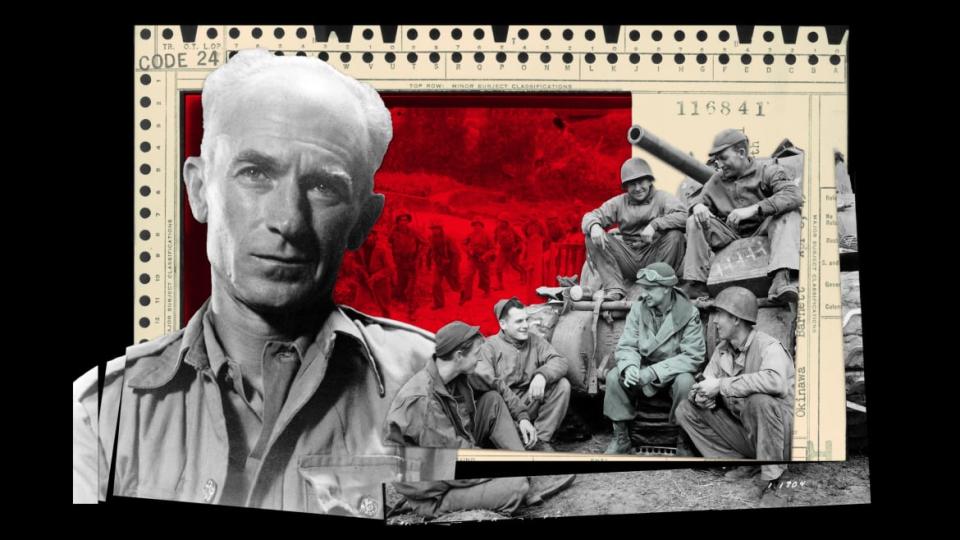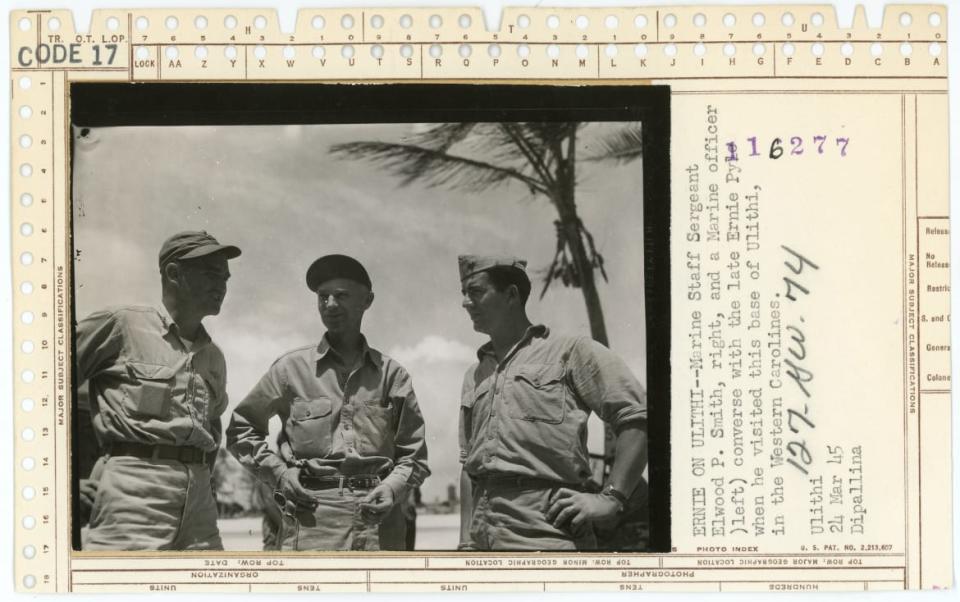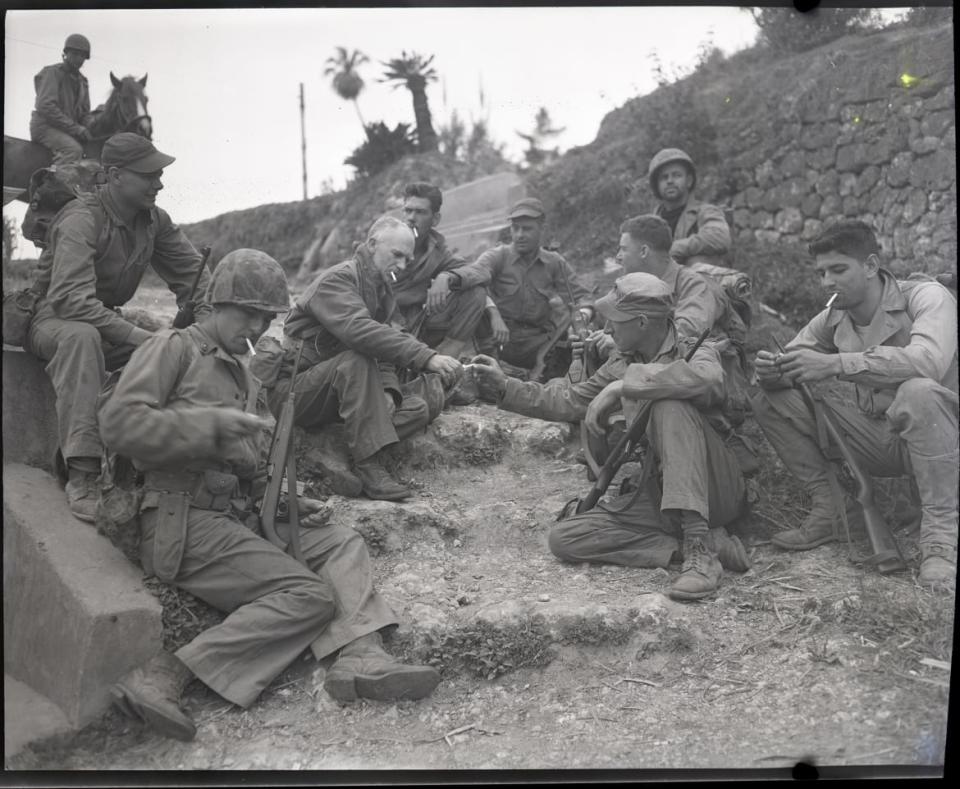Ernie Pyle Is There to Remind Us How Great War Correspondents Can Be

I’ve beaten Ernie Pyle’s lifespan by 10 years. Came 10 feet from losing that race, with a mortar landing on that side of a T-Wall in Iraq, instead of this side. A mundane near-miss during a summer 16 years ago, when I was a reporter embedded with the 82nd Airborne Division. I can listen to the mortar’s incoming rustle on the digital recording I didn’t know was running. I can hear the shotgun blast of the explosion and the shrapnel and my sharp breath. I can hear my first word a few minutes afterwards: “Fuck.”
“It’s good, though. You need a close call,” a soldier tells me, his voice recorded for posterity. “Make your stories more interesting.”
It’s too strong to say I felt Post-Traumatic Stress, reading David Chrisinger’s The Soldier’s Truth, his biography of World War II war reporter Ernie Pyle, but if you’ve been there, then you’ve been there.
The Soldier’s Truth condenses Pyle’s observations, from his columns and letters, into a relentless worldwide narrative of struggle, death, and grind. Chrisinger tells how Pyle faced trauma and took on a burden to relate moments banal and terrifying. Pyle had his share of greed, like any man, knowing his work would provide for his and his wife’s security, each trip overseas providing just a little bit more.
The book returned me to moments I once thought special—but that I have long learned are universal, during time at war, as both solider and reporter. That familiarity earned my trust.
Ernie Pyle at Normandy: They Weren’t Warriors, They Were American Boys
“Pyle didn’t have specific, unique experiences,” Chrisinger told The Daily Beast. “He had conventional (wartime) experiences, but he found the universal in the specific, and the specific in the universal. That’s what makes his work so timeless.”
Chrisinger tracks Pyle’s career across North Africa, Italy, and France, ending at a ridgeline on the Japanese island of Iejima, where he was killed on April 18, 1945. Chrisinger visited many of the locations, observing changes of people, politics, and time. Pyle’s body is in Plot D-109 of Honolulu’s Punchbowl Cemetery, his name memorialized with 240,000 war dead on Okinawa’s Cornerstone of Peace memorial.
An audience of 14 million readers read Pyle’s column in 500-plus nationwide newspapers. In perspective, that’s 10 percent of the United States’ 1945 population. He is the “patron saint of war correspondents,” Chrisinger says, and saints have no peers, at least among the living.
What do readers of today get from a book like this, after 20 years of our own wars, frustrated and cynical at our nation’s blundering failures? Truth, like the book’s title says. Not about war—any rube can tell a war story. About effort and cost and being tired, and realizing what a person can do, and taking responsibility to go and do it.
“This is a man who found what he was good at,” Chrisinger said. “The lesson is not to be Ernie Pyle, but to do what Ernie did to meet his purpose.”

Marine Staff Sergeant Elwood P. Smith (right) and a Marine officer (left) converse with the late Ernie Pyle (center) when he visited this base on Ulithi in the Western Carolines.
There are no writing lessons from Pyle, despite his wartime output of 700,000 words—and many more in a reporting career dating to 1923. As Chrisinger writes, “Ernie never shared the intimate details of his writing process. While he frequently complains about not being able to write or falling behind… he never details his strategies for building suspense or even goals he had for the column.”
So, no lessons for a young writer; no direction from Pyle, explaining how he wrote his leads or nut grafs. No series of drafts to show revision. His spare prose is in the Hemingway vibe of the time, Chrisinger said, though any modern reader of Cormac McCarthy would see a similar approach.
“If the stakes are clear,” Chrisinger said, “you don’t have to do a lot. Just tell it and get out of the way.”
Chrisinger wrote an introduction to a 2023 re-release of Brave Men, a collection of Pyle’s columns first printed in 1944. He notes Pyle’s direct and clean style in an example from Pyle’s Jan. 10, 1944 column, “The Death of Captain Waskow.”
Pyle writes: “The man looked into the dead captain’s face, and then he spoke to him, as though he were alive. He said: ‘I’m sorry, old man.’ …then he got up and walked away down the road in the moonlight, all alone.”
Chrisinger’s full excerpt is 193 words in eight sentences. “Only 94 unique words. No passive voice, no long noun phrases—all those clumsy writing crutches so many lesser writers use that gum up their prose and raise doubts… about the sincerity and authenticity of the storytelling,” Chrisinger writes.
“Some people dismiss Ernie,” Chrisinger said. “That he’s a letter writer or just writing feature stuff instead of the big picture. But that’s missing it. Him being so honest and observant, when a reader trusts the little thing, then when he tells the reader a big thing, you’re ready for it. He was building to a conclusion, even if it’s under the surface a little bit.
“Part of my motivation is pulling that curtain back—is he a propagandist? Is he a storyteller? That’s the wrong question,” Chrisinger said. “How did he do it? He treated people like human beings. He was so much more curious than judgmental.”
Pyle’s earliest reporting efforts stick to the facts at hand, letting the observation be the judgment. In February 1923, Pyle was a rookie reporter for the La Porte Daily Herald, and his stories are archived by the La Porte County Historical Society Museum. He was new to town and could attend a Ku Klux Klan recruiting meeting and no one would know he was a reporter. He transcribed the anti-Catholic, white supremacist, antisemitic speech by Klan leader C.E. Weller of Kokomo apparently as spoken.
The article includes an encounter outside the meeting hall as “one prominent minister slipped up a back street and cautiously looked around for the place of entrance.
“Right here,” said a bystander jestingly, “pull your cap down over your eyes and go on up.”
“I don’t need to pull my cap down,” replied the minister in a loud voice. “I’m 100 percent American.”
“Well, you don’t have to come up out of an alley to tell about it,” returned the bystander.
It’s 100 years later, so perspective can lead to wishful thinking—but the anecdote makes it seem like Pyle chose a side.
Pyle also includes that two Klansmen tried to “pump” him afterward, and “asked the local reporter what he was going to write about the meeting and he replied that he would simply tell what he had heard and seen.”
In Pyle’s writing, he was not often interested in the big picture, or conclusions or judgments—he stuck to what he could see and feel.
A Hollywood producer had recruited a young Arthur Miller—an up-and-coming playwright, but years before Death of a Salesman—to work with Pyle on a movie screenplay adapting his columns. The frail Miller, rejected from military service, had big ideas for the war story of the script, Chrisinger wrote.
The working script is a morality tale—one soldier deserts in the face of pointless death; another rallies the villagers of an Italian village to overthrow the fascist mayor. In the third act, the first soldier returns to the platoon, redeemed with new faith in their collective mission.
“I want to give a piece of meaning to all the bloodshed we have shown on the screen,” Miller told Pyle. “The war is about something. Because I don’t believe this war has no meaning.”
“Sure,” Pyle told him. “You put that in.”

Ernie Pyle talks to Division Commander, Major General Graves B. Erskine, commanding general of the 3rd Marine Division.
The movie, though not that script, eventually became The Story of G.J. Joe with Burgess Meredith playing a version of Ernie Pyle. Miller left the project; he never went to war, and he didn’t feel up to the task.
“(Ernie) tried to tell me that you couldn’t really tell it in words,” Chrisinger quotes Miller, writing in Situation Normal, Miller’s short 1944 memoir about his experiences on the movie project. “Not war, you couldn’t. He tried in many ways to make it clear to me. The need to tell the truth seemed like an ache he was always feeling.”
That conflict presented impossible dilemmas from 1942-1945. For the first two years at least, Pyle wrote without knowing the war’s outcome. To be optimistic was not truthful. To send copy through military censors for approval was not truthful. To hope that the dead soldiers from a variety of badly-planned campaigns would be worth the cost, was not truthful.
It’s not a lie if you believe it, but in his self-lacerating letters home to his editor Lee Miller, or his wife Jerry, he did not believe it all the time, either about the war or about himself.
“Ernie is representative of the Greatest Generation, and there’s a specific sort of spit-shine to him. You need see the 360 degrees of Ernie Pyle, why he made these choices, why he felt trapped,” Chrisinger said. “Going back again and again, what does that do to someone?
“What was the effect of doing your duty? Who are we beholden too? Your family? Your country? The guys in the squad? Looking at Ernie explores all that.”
Pyle’s approach centered on the men around him. He reduced his world to what he saw and heard, and left grand pronouncements for others. Searching for “meaning,” like Arthur Miller wanted to do, can be dangerous. Down that road are excuses and justifications. Pyle didn’t justify anything—if he saw it, and knew it, he could write it.
The Captain Waskow column is “one soldier dead on a mountain, but it brings the war into close and intimate range, and he was one of the first to do that,” Chrisinger said. “There’s a story that the war censor broke into tears and sent it through without making a single change. That’s probably apocryphal, but still, it was a revolutionary thing—newspapers weren’t publishing stories of individual soldiers dying in combat. Death was hidden,” at least in close-up form.
“Pyle read the room and wrote the story that people needed at the time.”
Humanize it
There are few modern comparisons to Ernie Pyle. Newspaper city columnists use the same observational, man-on-the-street storytelling approaches, but those jobs are becoming scarce. Opinions and analysis are everywhere—writers trying to force a conclusion because they wish it so.
“When I’m teaching policy writing (at the University of Chicago), I ask, are you talking with the people involved? If you can humanize it, you can access the story and process it. It’s so important to put a human face on it,” Chrisinger said. “Public policy communicators don’t always know how to do that.”
In a recent seminar with The War Horse military-related news site that Chrisinger works with, First Lady Jill Biden spoke to a group of Gold Star children, who had lost parents in war. They mentioned the cutoff for mental health care is 23 unless you’re in college. Why not make it 26, a slight bridge to adulthood?
“Jill Biden was excited about that, and mentioned that to her staff,” Chrisinger said. “You can’t tell me nobody’s written about the insurance gap before, but it’s necessary to humanize things.”
When asked what war correspondent does come close to Pyle, to that humanizing goal, Chrisinger names David Wood, who once reported from Iraq and Afghanistan for the Baltimore Sun.
Most of Wood’s articles for the Sun are behind paywalls that restrict access. Archives show Wood’s style shares Pyle’s approach of focusing first on individuals, before zooming out to try to give perspective.
Wood left the Sun during a round of April 2009 cutbacks. Then, on Memorial Day, 2009, the Sun published a front-page story about wartime injuries and rehabilitation but didn’t include a byline—the next day’s edition included the strange correction that the writer was Wood, “a former Sun reporter.”
Wood won a Pulitzer Prize for the Huffington Post in 2012, then cutbacks hit that company as well.
It is an interesting comparison in how Pyle was valued in his time and ours—books still in print today, old columns easy to locate and read, nationwide syndication, movies with him as the main character—as opposed to the war reporters of today, with missing bylines, paywalls, layoffs, broken links, or links that just all flood together in the sea of a Google search.
The front-page impact that Pyle could depend on doesn’t really exist anymore. His column on Capt. Henry Waskow was not on the front page of every paper—it was on page 10 on the Baltimore Evening Sun, page 2 of the Santa Cruz Sentinel-News, page 4 of the Brownsville Herald. But it was on page one of the Boston Globe and Huntsville Times, among others, accompanied by Pyle’s thumbnail picture.
The 1944 newspaper editors seemed to know the story was different—“None more stirring than his description of the touching farewells to a young Army captain,” one preview read. Another headlined the column, “Don’t read this… unless you can take it.” Melodrama, of course, but they knew they had something special to sell.

Columnist Ernie Pyle rests on the roadside with a patrol from the 1st Marine Division.
Seeing those earnest appeals can lead to cynicism when reading The Soldier’s Truth, and the lack of modern respect for the effort it takes to bear that witness. But Memorial Day is not for cynics.
“Dying men were brought into our tent, men whose death rattle silenced the conversation and made all of us thoughtful,” Pyle wrote in his Aug. 12, 1943 column, from Sicily. “When a man was almost gone, the surgeons would put a piece of gauze over his face. He could breathe… but we couldn’t see his face.
“The chaplain knelt down beside him and… said, ‘John, I’m going to say a prayer for you.’… and it was obvious to me that he meant the final prayer. It was as though he had said, ‘Brother, you may not know it, but your goose is cooked.’ When he had finished, the chaplain added, ‘John, you’re doing fine.’
“The dying man was left utterly alone, just lying there on his litter on the ground, lying in an aisle, because the tent was full… I felt like going over and at least holding his hand while he died, but it would have been out of order. I wish now I had.”
Chrisinger said that column was, “to me, the hinge moment where Ernie Pyle went from ‘I’m observing this’ to ‘I’m in this.’ That he has that responsibility.”
Pyle was our witness. It cost him the same as John, the dead veteran of Sicily. He wrote in longhand or a typewriter, from a foxhole or in a tent. He wrote the letter home. Pyle wrote the feeling of paralysis when the hand of the dying was so near, but time to make a choice so short. He brought the moment to a breakfast table or the soft chair after dinner. War arrived like a mortar, up close and personal.
Get the Daily Beast's biggest scoops and scandals delivered right to your inbox. Sign up now.
Stay informed and gain unlimited access to the Daily Beast's unmatched reporting. Subscribe now.

 Yahoo Sports
Yahoo Sports 